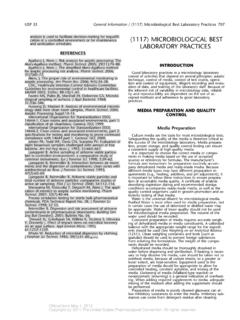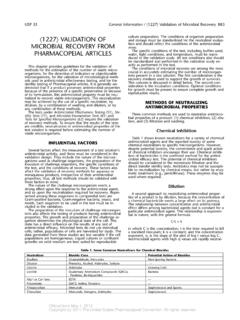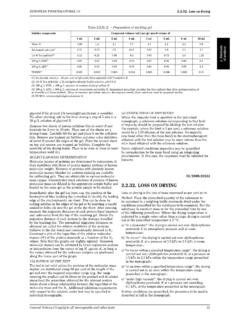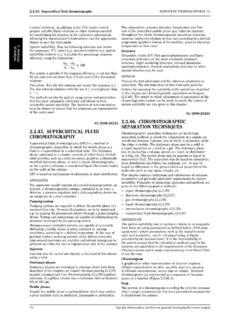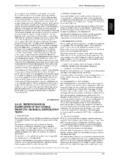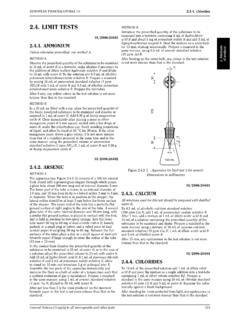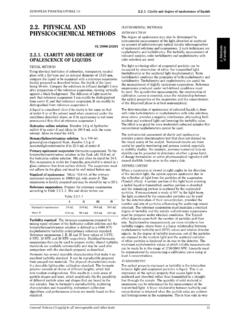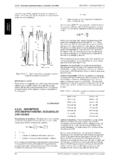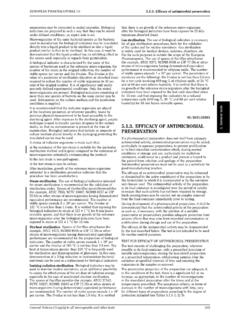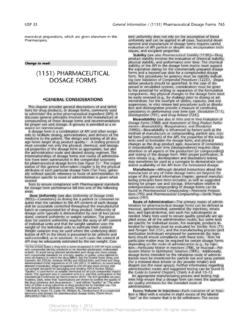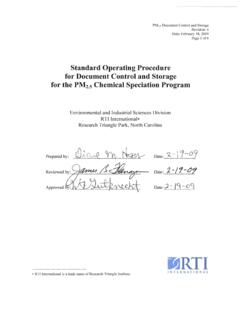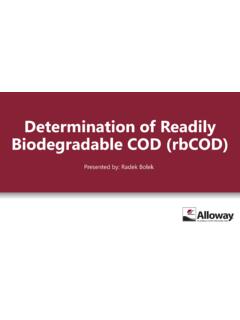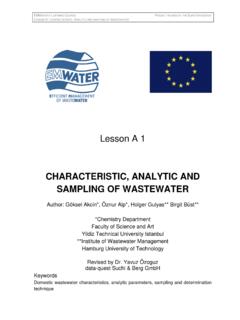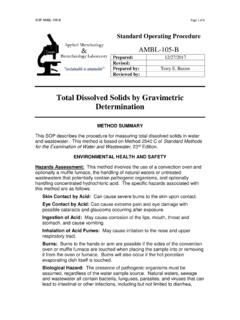Transcription of <731> LOSS ON DRYING - DrugFuture
1 USP 35 Physical Tests / 731 Loss on Drying317to within 20% for multi-element analyses, or when con-as an intensity reference for the analysis. An internal stan-centrations are <1 ng per mL. In cases where an individualdard should be used for ICP AES work and must always bemonograph provides different guidance regarding the reas-used for quantitative ICP MS check standard, the requirements of the monographLATERAL VIEWING:See Radial : The ion mass of method of standard additions should be employed inMULTIPLY-CHARGED IONS:Atoms that, when subjected to thesituations where matrix interferences are expected or sus-high-ionization temperature of the ICP, can form doubly orpected. This method involves adding a known concentrationtriply charged ions (X++, X+++, etc.)
2 When detected by MS,of the analyte element to the sample solution at no fewerthe apparent mass of these ions will be 1/2 or 1/3 that of thethan two concentration levels. The instrument response isatomic against the concentration of the added analyte ele-NEBULIZER:Used to form a consistent sample aerosol thatment, and a linear regression line is drawn through the datamixes with the argon gas, which is subsequently sent intopoints. The absolute value of the x-intercept multiplied bythe dilution factor is the concentration of the analyte in (OR COOLANT OR PLASMA) GAS:The main gas supply forthe GAS:See Outer (or Coolant or Plasma) VIEWING:A configuration of the plasma for AES inwhich the plasma is viewed orthogonal to the spectrometerFollow the procedure as directed in the individual mono-optic path.
3 Also called side-on viewing. See also Lateralgraph for the detection mode and instrument specification of definitive parameters in a monographdoes not preclude the use of other suitable operating condi-REACTION CELL:Similar to Collision Cell, but operating on ations, and adjustments of operating conditions may be nec-different principle. Designed to reduce or eliminate spectralessary. Alternative conditions must be supported by data, and the conditions in the monograph willSAMPLING CONE:A metal cone (usually nickel-, aluminum-,take precedence for official purposes. Because of differencesor platinum-tipped) with a small opening, through whichin manufacturers equipment configurations, the analystionized sample material flows after leaving the wish to begin with the manufacturer s suggested de-SEQUENTIAL:A type of detector configuration for AES or MSfault conditions and modify them as needed.
4 Data collectedin which discrete emission lines or isotopic peaks are ob-from a single sample introduction are treated as a singleserved by scanning or hopping across the spectral range byresult. Data collected from replicate sequential readingsmeans of a monochromator or scanning mass a single introduction of the appropriate standard orSIMULTANEOUS:A type of detector configuration for AES orsample solutions are averaged as a single result. SampleMS in which all selected emission lines or isotopic peaks areconcentrations are calculated versus the working curve gen-observed at the same time by using a polychromator orerated by plotting the detector response versus the concen-simultaneous mass spectrometer, offering increased analysistration of the analyte in the standard solutions.
5 With mod-speed for analyses of multi-element instruments, this calculation is often performed by theSKIMMER CONE:A metal cone through which ionized after leaving the sampling cone and before enteringthe high-vacuum region of an ICP ADDITIONS:A method used to determine the ac-tual analyte concentration in a sample when viscosity or ma-AUXILIARY GAS:See Intermediate (or Auxiliary) effects might cause erroneous VIEWING:A configuration of the plasma for AES inTORCH:A series of three concentric tubes, usually manufac-which the plasma is directed toward the spectrometer opti-tured from quartz, in which the ICP is path, also called end-on viewing. CENTRAL (OR NEBULIZER) GAS:One of three argon gas flows inan ICP torch. The central gas is used to help create a finemist of the sample solution when solution nebulization isemployed.
6 This fine mist is then directed through the cen-tral tube of the torch and into the CELL:A design feature of some ICP MS instru- 731 LOSS ON DRYING ments. Collision cells are used to reduce interferences fromargon species or polyatomic ions and facilitate the analysisof elements that might be affected by those procedure set forth in this chapter determines theCOOL PLASMA:Plasma conditions used for ICP MS that resultamount of volatile matter of any kind that is driven offin a plasma that is cooler than that normally used for anunder the conditions specified. For substances appearing toanalysis. This condition is achieved by using a lower forwardcontain water as the only volatile constituent, the procedurepower setting and higher central-gas flow rate, and is usedgiven in the chapter, Water determination 921 , is appropri-to help reduce isotopic interferences caused by argon andate, and is specified in the individual polyatomic otherwise directed in the individual monograph,COOLANT GAS:See Outer (or Coolant or Plasma) the determination on a 1 to 2g test specimen.
7 Mixthe substance to be tested and, if it is in the form of largeFORWARD POWER:The number of watts used to ignite andparticles, reduce the particle size to about 2 mm by quicklysustain the plasma during an analysis. Forward power re-crushing before weighing out the test specimen. Tare anquirements may vary, depending on sample matrix andappropriate glass-stoppered, shallow weighing bottle been dried for about 30 minutes under the same condi-INTERMEDIATE (OR AUXILIARY) GAS:Gas used to lift the plasmations to be employed in the determination and cooled tooff the surface of the torch, thereby preventing melting ofroom temperature in a desiccator. Put the test specimen inthe intermediate tube and the formation of carbon and saltthe bottle, replace the cover, and accurately weigh the bot-deposits on the inner and the contents.
8 By gentle, sidewise shaking, distributeINTERNAL STANDARD:An element added to or present in thethe test specimen as evenly as practicable to a depth ofsame concentration in blanks, standards, and samples to actabout 5 mm generally, and not more than 10 mm in theOfficial from May 1, 2012 Copyright (c) 2011 The United States Pharmacopeial Convention. All rights from by nEwp0rt1 on Fri Dec 02 21:23:03 EST 2011318 731 Loss on DRYING / Physical TestsUSP 35case of bulky materials. Place the loaded bottle in the dryingcrucible, and cover at the temperature ( 25 ) and for thechamber, removing the stopper and leaving it also in theperiod of time designated in the individual monograph. Ig-chamber. Dry the test specimen at the temperature and fornite for successive 1-hour periods where ignition to constantthe time specified in the monograph.
9 [NOTE The tempera-weight is indicated. Upon completion of each ignition,ture specified in the monograph is to be regarded as beingcover the crucible, and allow it to cool in a desiccator towithin the range of 2 of the stated figure.] Upon openingroom temperature before chamber, close the bottle promptly, and allow it tocome to room temperature in a desiccator before the substance melts at a lower temperature than thatspecified for the determination of Loss on DRYING , maintainthe bottle with its contents for 1 to 2 hours at a tempera-ture 5 to 10 below the melting temperature, then dry atthe specified temperature. 736 MASS SPECTROMETRYW here Capsules are to be tested, use a portion of themixed contents of not fewer than 4 Tablets are to be tested, use powder from notA mass spectrometer produces ions from the substancefewer than 4 investigation, separates them according to their mass-Where the individual monograph directs that loss on dry-to-charge ratio (m/z), and records the relative abundance ofing be determined by thermogravimetric analysis, a sensitiveeach ionic species present.
10 The instrument consists of threeelectrobalance is to be components (see Figure 1):Where DRYING in vacuum over a desiccant is directed inthe individual monograph, a vacuum desiccator or a vac-uum DRYING pistol, or other suitable vacuum DRYING appara-tus, is to be DRYING in a desiccator is specified, exercise particu-lar care to ensure that the desiccant is kept fully effective byfrequent DRYING in a capillary-stoppered bottle* in vacuum isdirected in the individual monograph, use a bottle or tubefitted with a stopper having a 225 25 mm diameter capil-lary, and maintain the heating chamber at a pressure of 5mm or less of mercury. At the end of the heating period,admit dry air to the heating chamber, remove the bottle,and with the capillary stopper still in place allow it to coolto room temperature in a desiccator before 1.
